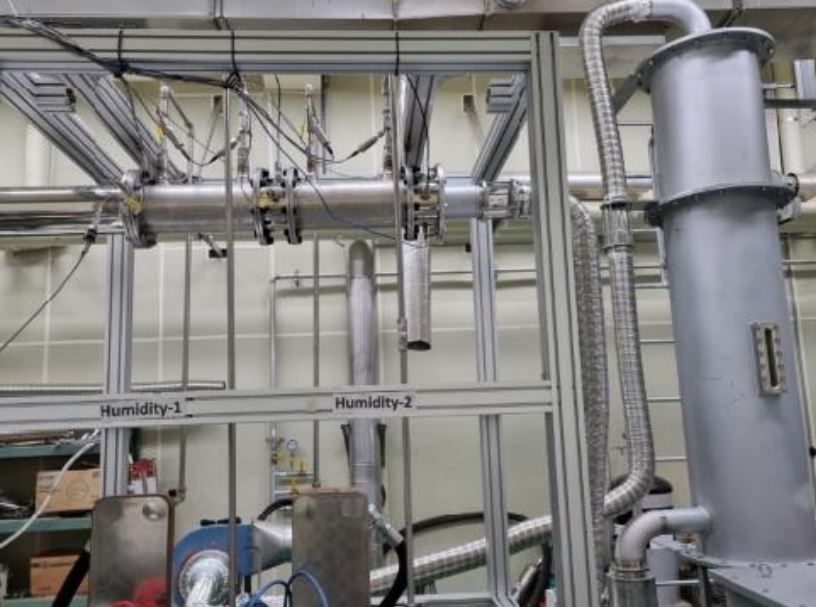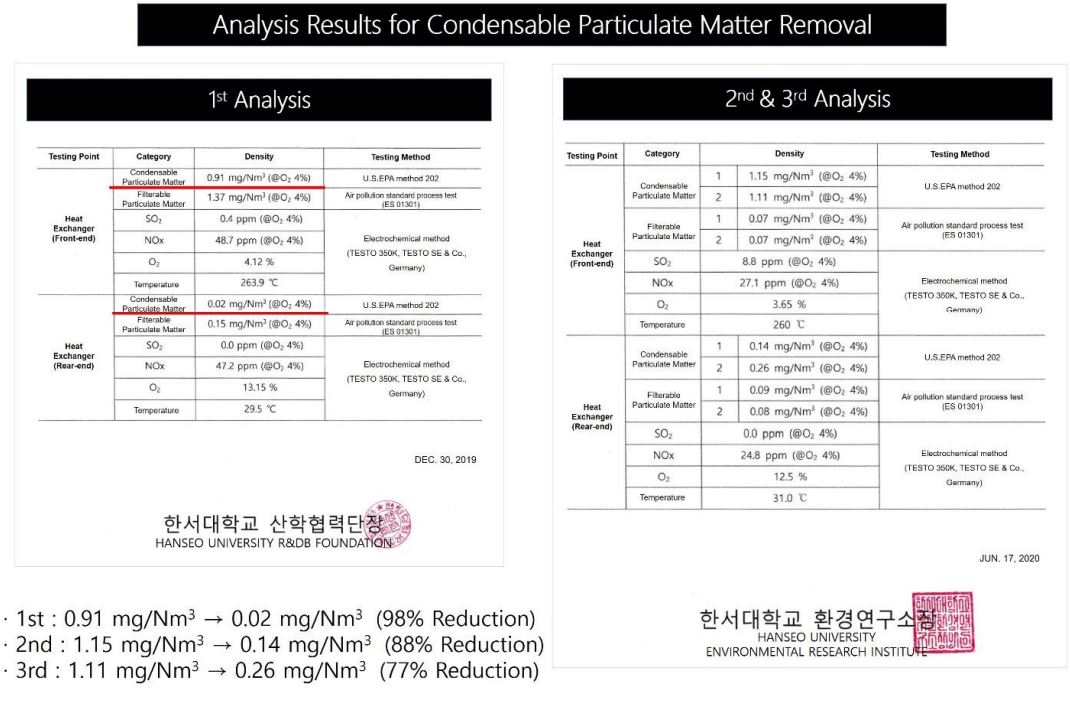
- Created2022.02.15
Development of a System for Removing Condensable Particulate Matter from Smokestack Plumes
- Hybrid cooling and absorption method removes white smoke and condensable particulate matter simultaneously -
- The new system rapidly cools hot smoke and captures gaseous dust as liquid -
A newly developed technology has been introduced with the capacity to convert condensable particulate matter found in white smoke plumes, mainly generated from thermal power plants and waste incinerators, into liquid. Despite the fact that the condensable particulate matter found in these plumes contains compounds harmful to the human body, such as organic carbon and sulfate, emissions of such smoke have not yet been regulated. As such, this technology is expected to help solve the issue of condensable particulate matter emissions.
Principal Researcher Dr. Youngmin Kim of the Department of Engine Research in the Environment System Research Division at the Korea Institute of Machinery and Materials (President Sang Jin Park, hereafter referred to as KIMM), developed a ‘hybrid cooling and absorption system for particulate matter dust removal’. This system removes pollutants by simultaneously applying cooling and absorption functions to plumes emitted from smokestacks.
Most of the plumes emitted from the smokestacks of thermal power plants or other business sites are mainly moisture. However, some condensable particulate matter that is harmful to the human body can also be found within such smoke. When condensable particulate matter is first discharged into the atmosphere at a high temperature, it initially stays in a gaseous state. But as it cools, it then changes into particles thus making it rather difficult to remove.
Condensable particulate matter and moisture found in these plumes are contributing factors to frozen roads in the winter. Furthermore, they can reduce the amount of sunlight or hinder the spread of pollutants in the air, which can worsen the air quality in nearby areas.
The KIMM research team cooled the gas, which reached temperatures above 100°C, from the smokestacks to room temperature before it was discharged. After the cooling process, when the gas changed into a liquid state, the excess moisture was removed with a filter and any condensable particulate matter was also filtered out
Through this process, the KIMM research team was able to remove 70% and 80% of the moisture and condensable particulate matter from the target gas, respectively. Then, they sprayed an absorbent that dissolves the remaining moisture, before absorbing and removing the moisture once again. In the end, it was found that, when compared to the original state of the smoke when it was initially discharged, up to 85% of moisture and condensable particulate matter were removed.
Until now, a relatively simple cooling method has been applied to remove such plumes, but this method alone is not very effective. On the other hand, the absorbent method, despite its high efficiency in smoke removal, has limitations in that the device configuration is complicated and that reusing the absorbent requires a lot of heat energy.
The KIMM research team applied the absorbent method after first removing as much white smoke and condensable fine dust as possible using the existing simplistic cooling method. As a result, it was found that the initial cooling reduced the burdens faced using the absorbent method. Specifically, the heat recovered during the cooling process could be used in the regeneration process, in which the absorbent and moisture could be separated and used again.
Principal Researcher Dr. Youngmin Kim stated that this technology can be used to simultaneously remove not only white smoke, but also condensable particulate matter that has not been properly managed, all while also recovering 100% of exhaust heat at room temperature for further use. He proceeded to explain that this technology can be used to dramatically reduce the amount of moisture and condensable particulate matter in the exhaust gas emitted from smokestacks of industry plants.
The KIMM research team has conducted a technology transfer with this technology to HIGHEST, Inc., an environmental facility company, with plans to scale up the system capacities for the purpose of promoting on-site demonstration projects.
[List of Attachments] - Attachment 1: White smoke and condensable particulate matter removal system (Photo)
- Attachment 2: White smoke and condensable particulate matter test results (Graph)
The Korea Institute of Machinery and Materials (KIMM) is a non-profit governmentfunded research institute under the Ministry of Science and ICT. Since its foundation in 1976, KIMM is contributing to economic growth of the nation by performing R&D on key technologies in machinery and materials, conducting reliability test evaluation, and commercializing the developed products and technologies.
This research was carried out with the support of the KIMM project titled, “The Development of a Hybrid White Smoke and Exhaust Emission Reduction System Combining Cooling and Absorption Technologies.”
Credit : The Korea Institute of Machinery and Materials (KIMM)
Usage Restrictions of Multimedia (Attachment File) : The sources of photos and research results from KIMM must be specified.
- Attachment 1: White smoke and condensable fine dust removal system (Photo)

Description: Principal Researcher Dr. Youngmin Kim of the Department of Engine Research at the KIMM has developed a hybrid cooling and absorption condensable particulate matter removal technology that can simultaneously remove white smoke and condensable particulate matter. This technology removes exhaust gas generated from a boiler installed in the laboratory through a primary cooling and secondary absorbent method.
- Attachment 2: White smoke and condensable fine dust removal test results (Graph)

Description: Principal Researcher Youngmin Kim of the Department of Engine Research at the KIMM has developed a hybrid cooling and absorption condensable particulate matter removal technology that can simultaneously remove white smoke and condensable particulate matter. The results of a condensable particulate matter reduction test showed an average removal effect of 85% or more.



